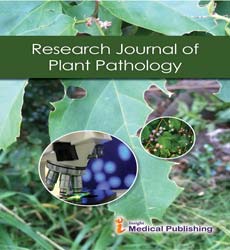Assessment of Boundary Plants for the Tomato Yellow Leaf Twist Illness
Palent Wung*
Department of Plant Biology, Wuhan University of Technology, Wuhan, China
- *Corresponding Author:
- Palent Wung
Department of Plant Biology,
Wuhan University of Technology, Wuhan,
China,
E-mail: Wung_P@yahoo.com
Received date: August 17, 2023, Manuscript No. IPRJPP-23-18014; Editor assigned date: August 21, 2023, PreQC No. IPRJPP-23-18014 (PQ); Reviewed date: September 04, 2023, QC No. IPRJPP-23-18014; Revised date: September 11, 2023, Manuscript No. IPRJPP-23-18014 (R); Published date: September 18, 2023, DOI: 10.36648/iprjpp.6.3.174
Citation: Wung P (2023) Assessment of Boundary Plants for the Tomato Yellow Leaf Twist Illness. J Res Plant Pathol Vol.6 No.3: 174.
Description
Plant microbes cause tremendous misfortunes in crop yields around the world. In the beyond couple of years, the drawn out utilization of copper and anti-infection agents has prompted boundless bacterial opposition. Notwithstanding constant endeavours to investigate new anti-toxins or variations with elective activities, the obstruction even to novel anti-infection agent’s shows up very quick in the field-when one year after application, and accordingly their utilization appears to be probably not going to tackle the issue of medication opposition. Albeit fundamental gained obstruction can work on the general capacity of plants to oppose microbes, their exorbitant utilization of some SAR inducers likewise influences plant physiology, prompting adverse consequences on crop yields. Hematoporphyrin (HP), an original photosensitizer with extraordinary photodynamic movement, has been broadly utilized in photodynamic anticancer. Notwithstanding, HP is effectively oxidized by ROS created by self-catalysis causing the deficiency of photodynamic action with illumination time, which makes HP less appropriate for direct use in plant infectious prevention in open field conditions. Moreover, HP promptly shapes dimers or higher totals in a fluid arrangement on account of serious areas of strength for its, bringing about poor photodynamic productivity.
Illness of Microorganisms
Antimicrobial photodynamic inactivation of microbes is arising as an elective system to battle safe plant microorganisms. Photodynamic inactivation uses light-delicate particles that produce responsive oxygen species ready to kill microorganisms upon enlightenment. Contrasted and different treatments, aPDI enjoys a few benefits. First and foremost, it can locally kill microorganisms, diminishing the symptoms of photodynamic inactivation. Furthermore, aPDI follows up on various variable cell targets, so it isn't considered to prompt medication obstruction. Likewise, contrasted and the treatment of human illnesses, photodynamic inactivation of plant microorganisms can utilize daylight without exceptional counterfeit light. Besides, there is compelling reason need to think about long haul photo toxicity and tissue vulnerability. Regardless of these benefits and expanding information about the viability of photodynamic inactivation, aPDI-related research is to a great extent zeroed in on controlling illnesses prompted by human pathogenic microbes. Applications connected with plant infections have seldom been reported. Currently, synthetic pesticides are the essential means for controlling yield sicknesses and they are frequently viewed as key to supply secure the worldwide food. It may, other than expanding the expense of farming creation, the broad utilization of agrochemicals led to numerous natural and cultural issues. First and foremost, pesticide openness represents an immediate danger to human wellbeing and the unpredictable utilization of agrochemicals caused pesticide build-ups in food, which increment sanitation gambles. Besides, the unpredictable utilization of agrochemicals kills enormous quantities of non-target life forms, obliterating rural biodiversity and the equilibrium of the environment. Thirdly, the aimless utilization of agrochemicals prompts pesticide deposits in soil and water, which influences farmland natural security. At long last, substance pesticides have likewise caused the improvement of safe kinds of microorganisms and irritations, which prompts more pesticide use, exasperating the issue. Of course, compound pesticides have been prohibited by Europe in postharvest stone organic product. Hence, innovative work of new advancements of plant infectious prevention, while limiting synthetic pesticides, is direly expected to work with the change from conventional substance control to present day green control of plant sickness, which is more secure for human wellbeing and the climate.
Viral Illnesses
Hence, in this review, we frame the different techniques of feasible counteraction and control and future points of view of this methodology with a significant spotlight on the inducers of plant immunity. Intercropping alludes to all the while growing a few harvests in a similar field, which can lessen bug pervasion and the rate of viral illnesses. Boundary trimming, nonsusceptible plants lining an essential harvest, assumes a fundamental part in controlling bug vermin and bug sent illnesses in social control. To control aphid-communicated viral illnesses, hindrance plants can act as actual boundaries that block winged aphids arriving on essential harvests. As per the infection sink speculation, obstruction plants go about as an infection sink to cleanse the infection in the mouthparts of aphids, subsequently diminishing the event of infection transmission. Trap editing is another procedure that includes developing more appealing plants for drawing aphids to settle and colonize on them, along these lines safeguarding essential harvests. Obstruction trimming, intercropping, or trap editing is frequently coordinated to control aphid-sent viral diseases. Barrier trimming has been demonstrated proficient in smothering the spread of nonpersistently communicated infections. Another field preliminary uncovered that establishing oat and shaggy vetch as intercrop plants with seed potato crops fundamentally decreased PVY frequency in potato fields.
Open Access Journals
- Aquaculture & Veterinary Science
- Chemistry & Chemical Sciences
- Clinical Sciences
- Engineering
- General Science
- Genetics & Molecular Biology
- Health Care & Nursing
- Immunology & Microbiology
- Materials Science
- Mathematics & Physics
- Medical Sciences
- Neurology & Psychiatry
- Oncology & Cancer Science
- Pharmaceutical Sciences
